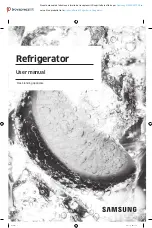
User Manual
16
Cleaning
WARNING
Before cleaning the appliance, make sure it is
switched off and disconnected from the power
supply.
Failure to do so can result in electric shock or injury.
• Dust behind the refrigerator and on the ground
shall be timely cleaned to improve the cooling
effect and energy saving.
• Check the door gasket regularly to make sure
there are no debris. Clean the door gasket with a
soft cloth dampened with soapy water or diluted
detergent.
• The interior of the refrigerator should be cleaned
regularly to avoid odor.
• Please turn off the power before cleaning interior,
remove all foods, drinks ,shelves, drawers, etc.
• Use a soft cloth or sponge to clean the inside of
the refrigerator, with two tablespoons of baking
soda and a quart of warm water. Then rinse with
water and wipe clean. After cleaning, open the
door and let it dry naturally before turning on the
power.
• For areas that are difficult to clean in the
refrigerator (such as narrow sandwiches,
gaps or corners), it is recommended to wipe
them regularly with a soft rag, soft brush, etc.
and when necessary, combined with some
auxiliary tools (such as thin sticks) to ensure no
contaminants or bacterial accumulation in these
areas.
• Do not use soap, detergent, scrub powder, spray
cleaner, etc., as these may cause odors in the
interior of the refrigerator or contaminated food.
• Clean the bottle frame, shelves and drawers
with a soft cloth dampened with soapy water or
diluted detergent. Dry with a soft cloth or dry
naturally.
• Wipe the outer surface of the refrigerator with a
soft cloth dampened with soapy water, detergent,
etc , and then wipe dry.
• Do not use hard brushes, clean steel balls, wire
brushes, abrasives (such as toothpastes), organic
solvents (such as alcohol, acetone, banana oil,
etc.), boiling water, acid or alkaline items, which
may damage the fridge surface and interior.
Boiling water and organic solvents such as
benzene may deform or damage plastic parts.
• Do not rinse directly with water or other liquids
during cleaning to avoid short circuits or affect
electrical insulation after immersion.
•
Never use boiling water to accelerate defrosting
as it may damage the plastic components.
• After everything is dry, place appliance back into
operation.
• Allow approximately 1–2 hours for the cabinet to
cool down again (depending on the length of time
the appliance was disconnected from the power).
WARNING
Never clean the unit with an abrasive, acid, oil or
solvent based cleaning agent. Never use flammable
fluids or sprays for cleaning as the fumes from these
substances can create a fire hazard or Explosion.
Defrosting
The refrigerator is made based on the air-cooling
principle and thus has automatic defrosting
function. Frost formed due to change of season
or temperature may also be manually removed by
disconnection of the appliance from power supply
or by wiping with a dry towel.
Cleaning the door trays
• According to the direction arrow in the figure
below, use both hands to squeeze the tray, and
push it upward, then you can take it out.
• After washing the tray having been taken out, you
can adjust its installing height in accordance with
your requirement.
Maintenance and Cleaning
15









































